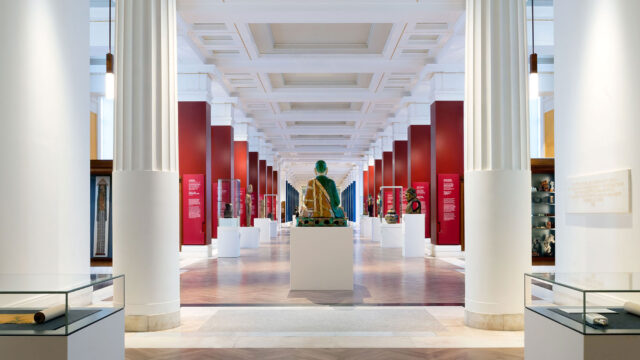China’s hidden century
British Museum
Examining the resilience and innovation of 19th-century China
Exhibition Design, Graphic Design, Selected












‘China’s hidden century’ focuses on the tumultuous period between 1796 and 1912, which led to the end of over 2,000 years of Qing dynastic rule and paved the way for the modern Chinese republic. This temporary exhibition for the British Museum reveals a period of turmoil, but also of great innovation and creativity, driven by political, cultural and technological change. In the shadow of these events lie the stories of remarkable individuals – at court, in the military, in booming cosmopolitan cities and on the global stage – through which the period is brought to life.
The exhibition features over 300 objects, many of which were very large in size, including a number of colourful and beautifully-crafted costumes. An early-stage design decision was that the exhibition’s structures, colours and interpretation should sit seamlessly alongside and not compete with these spectacular objects. Nissen Richards Studio therefore designed the exhibition so the visitor would go on a journey through 19th-century China via a theatrical architecture, with the exhibition’s look and style created through the setting of a white and shifting shadowy world, using interesting and unusual fabrics and textured materials.
The exhibition’s six key sections mostly feature a subtle geographical locator – or associated landscape – and are developed with a focus on a set group of people. Objects are then embedded within the exhibition’s architecture to become intrinsic parts of the room they’re in, surrounded by the evocative, shifting atmospheres which create a sense of place and evoke the settings for the people who lived or worked there.
Large-scale environmental graphics talk about people, places, and craft. Although the whole exhibition acts as an architectural series of interventions, there is a subtle shifting colour palette with that too, based on a subdued Qing colour palette. This is seen in highlights, and in fabric textures within showcases. The key graphic language of the exhibition is the use of banners, which are allusive and ethereal. The graphic approach was also based on a sense of place, using paintings of landscapes, the mountains and the sea, taken from images of the period – many in the exhibition.
The designs also include light, tonal shifts and sometimes graphic mark-making, as well as the creation of shadow photography of the key, highlighted individuals in the story, which was the result of a special collaboration between the British Museum, Nissen Richards Studio and students from the London College of Fashion. Students created costumes for each character, using a mixture of details guided by the Museum’s experts – combined with theatrical imaginings. This collaboration was incredibly fruitful and involved a workshop by the film and stage costume designer Tim Yip, who took part in a masterclass and gave an inspiring talk to the students.
Client
British Museum
Location
London
Role
Exhibition Designer
Graphic Designer
Collaborators
Lighting Design: Beam Lighting Design
London College of Fashion Collaboration:
Students: Jialin Li, Yongyi Yin, Min Liang, Maria Evstyukhina, Xuanran Zhou, Yiqi Nie
Course Leader MA Costume Design for Performance: Agnes Treplin
Senior Research Fellow and Principal Lecturer in design for performance: Donatella Barbieri
Models: Wenyuan Xin, Isaac Li, Betty Yao, Dr. Nora Yitong Qiu, Ruiliang Liu, Clark Ho
Director of Photography: Pete Bateson
Photography: Gareth Gardner
Courtesy of Royal Ontario Museum, Toronto, Canada
Copyright: Gareth Gardner and the Trustees of the British Museum



